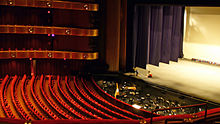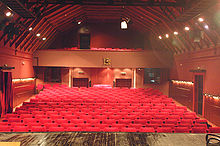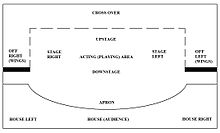- Parts of a theatre
-
 The classic proscenium style stage of the New York State Theater.
The classic proscenium style stage of the New York State Theater.
Contents
Types of theatres
Main article: Stage (theatre)- Arena/Stadium: The playing area is in the center of a large open space which usually seats thousands of people.
- Proscenium: The audience directly faces the playing area which is separated by a portal called the proscenium arch. The stage is often raised a few feet higher than the first rows of the audience. The audience is on a rake, getting higher as the seating goes towards the rear of the house.
- Thrust: The playing area protrudes out into the house with the audience seating on more than one side.
- Theatre in the round: The playing area is surrounded by audience seating on all sides.
- Traverse: The elongated playing area is surrounded by audience seating on two sides.
- Black box theater: A bare-bones stage of various seating types.
Stage
The area of the theatre in which the performance takes place is referred to as the stage. In order to keep track of where things are and where they need to go, the stage is divided up into sections and is oriented based on the performers perspective to the audience.
- Upstage: The area of the stage furthest from the audience.
- Downstage: The area of the stage closest to the audience.
- Stage Left: The area of the stage to the performer's left, when facing downstage (i.e. the audience).
- Stage Right: The area of the stage to the performer's right, when facing downstage (i.e. the audience).
- Center Stage: The center of the playing area.
- Center Line: An imaginary reference line on the playing area that indicates the exact center of the stage.
- Wings: Areas that are part of a stage deck but offstage (out of sight of the audience). The wings are typically separated using drapes (usually black). Often there will be 2, 3, or even 4 different "portals" which consist of a wing curtain (or leg) on each side of the stage and a teaser drape (or border.) It is used for performers preparing to enter, storage of sets for slow changes and as a stagehand work area. Wings also hide technical equipment, such as lights which project from the side of the stage.
- Rake: A slope in the performance space (stage), rising away from the audience.
- Shell:A hard, often removable surface, designed to reflect sound out into the audience for musical performances.
- Prompt corner: Area just to one side of the proscenium where the stage manager stands to cue the show and prompt performers.
- Proscenium: The portal that divides the audience from the stage.
- Plaster Line: An imaginary reference line on the playing area that indicates where the proscenium arch is. Typically, the plaster line runs across the stage at the back face (upstage face) of the proscenium wall.
- Safety curtain: A heavy fiberglass or iron curtain located immediately behind the proscenium.
- Apron: The area of the stage in front of the proscenium arch.
House
 A view from a stage showing the control booths, a balcony, and some catwalks, Knjaževsko-srpski teatar
A view from a stage showing the control booths, a balcony, and some catwalks, Knjaževsko-srpski teatar
The house can refer to any area which is not considered playing space or backstage area. Outside the theatre itself this includes the lobby, coat check, ticketing counters, and restrooms. More specifically, the house refers to any area in the theatre where the audience is seated. This can also include aisles, the orchestra pit, control booth and balcony.
- Orchestra or Orchestra Pit: In productions where live music is required, such as ballet, opera, and musicals, the orchestra is positioned in front and below of the stage in a pit. The pit is usually a large opening ranging from 4'-6' wide, 20'-30' long and 6'-10' deep. Some orchestra pits have lifts or elevators that can raise the floor of the pit up to the same height as the stage. This allows for easier movement of instruments among other things. Often an orchestra pit will be equipped with a removable pit cover which provides safety by eliminating the steep drop off and also increases the available acting area above. In most cases, some sort of lattice or sound port is built into the front of the orchestra pit, to allow audience members in the front rows to hear the music while still having a wall to keep them separated from the orchestra.
- Auditorium: The section of the theatre designated for the viewing of a performance. Includes the patrons main seating area, balconies, boxes, and entrances from the lobby. Typically the control booth is located in the back of the auditorium, although for some types of performance an audio mixing positing in located closer to the stage within the seating.
- Vomitorium: A passage situated below or behind a tier of seats.
- Control Booth: The section of the theatre designated for the operation of technical equipment, followspots, lighting and sound boards, and is sometimes the location of the stage manager's station. The control booth is located in the theatre in such a way that there is a good, unobstructed view of the playing area without causing any (or minimal) distraction to the audience (i.e. preventing distracting light leak or noise), and is generally an enclosed space.
- Catwalks: A catwalk is a section of the house hidden in the ceiling from which many of the technical functions of a theatre, such as lighting and sound, may be manipulated.
Front of House
Main article: Front of house- Lobby: The lobby is a room in a theatre which is used for public entry to the building from the outside. Ticket counters, coat check, concessions and restrooms are all usually located in, or just off the lobby.
- Box office: A place where tickets are sold to the public for admission to a venue
- Marquee: Signage stating either the name of the establishment or the play and the artist(s) appearing at that venue.
Backstage or Offstage
The areas of a theatre that are not part of the house or stage are considered part of backstage. These areas include dressing rooms, green rooms, offstage areas (i.e. wings), cross-overs, fly rails or linesets, dimmer rooms, shops and storage areas.
- Dressing Rooms: Rooms where cast members apply wigs, make-up and change into costumes. Depending on the size of the theatre, there may be only a male and female dressing room, or there might be many (i.e. one for each member of the cast). Often in larger spaces, cast members in lead roles have their own dressing room, those in supporting roles share with one or two others and those in the background or 'chorus' roles share with up to 10 or 15 other people. Dressing rooms generally feature a large number of switchable outlets for accessories like hair dryers, straightening irons, and curlers. They also feature mirrors, which are often lit. Sinks are present for the removal of makeup and sometimes a dressing room will have showers and restrooms attached. Lockers, or costume racks are generally used for storage of costumes. In some performances, dressing rooms are used as a secondary green room because of space limitation or noise, especially by performers with long breaks between stage appearances.
- Green Room: The lounge backstage. This is the room where actors and other performers wait in when they are not needed onstage or in their dressing rooms.
- Crossover: A crossover is a hallway, room, or catwalk designed to allow actors in a theater to move from wings on one side of a stage to wings on the other side without being seen by the audience. Sometimes this is built as a part of the theater, sometimes exiting the building is required, and still other times the set includes a false wall to create a temporary crossover. A trap room, orchestra pit, or even the front of house can be used as crossovers.
- Fly System: A fly system is a system of ropes, counterweights, pulleys, and other such tools designed to allow a technical crew to quickly move set pieces, lights, and microphones on and off stage quickly by 'flying' them in from a large opening above the stage known as a fly tower/flyspace
- Catwalk: A catwalk is an elevated platform from which many of the technical functions of a theatre, such as lighting and sound, may be manipulated.
- Dimmer Room: The room backstage which contains the dimmer racks which power the lighting rig in the theatre. Often dimmer racks may not be housed in dedicated room, instead they may be in a mechanical room, control booth, or catwalk, or even on the side of the stage as is often the case on Broadway, touring shows, or at corporate events. When the dimmers are stored onstage, this area of the stage is known as the 'Dimmer Beach'.
- Shops and storage areas: Depending on the space available a theatre may have its own storage areas for old scenic and costume elements as well as lighting and sound equipment. The theatre may also include its own lighting, scenic, costume and sound shops. In these shops each element of the show is constructed and prepared for each production.
- Call board: Literally a backstage bulletin board which contains information about a theatrical production including contact sheets, schedules, rehearsal time changes, etc.
- Trap room: A large open space under the stage of many large theatres. The trap room allows the stage floor to be leveled, extra electrical equipment to be attached, and most importantly, the placement of trap doors onto the stage (hence the name). It is usually unfinished and often doubles as a storage area. It is often also used as a substitute for a crossover.
References
- Friedman, Sally (1994). Backstage Handbook: an illustrated almanac of technical information., Broadway Press.
Categories:- Parts of a theatre
- Stage terminology
Wikimedia Foundation. 2010.

